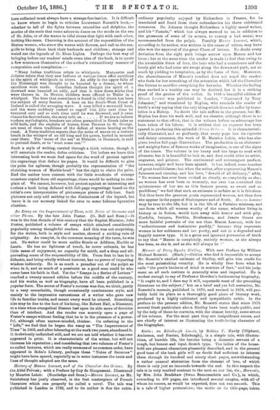Legends and Superstitions of the Sea and of Sailors. By
F. S. Bassett, Lieutenant U.S. Navy. (Sampson Low and Co.) ŌĆöThis is a book which, were it not so full of interesting matter, would be pro- voking on account of its extreme incoherence. In four hundred closely printed pages, legends and stories on every conceivable sub- ject connected with the sea or sailors are jostled higgledy-piggledy together. It is a huge commonplace book of sailors' yarne,ŌĆöa sea- captain's log-book of his cruise through literature. To those who are of the race that of old worshipped the open heaven and the great forces of NatureŌĆöthe clouds, winds, and wavesŌĆöthe tales and fancies here collected mast always have a strange fascination. It is difficult to know where to begin to criticise Lieutenant Bassett's book,ŌĆö whether to tell of the fights between crocodiles and dolphins, the stories of the seals that come ashore to dance on the sands on the eve of St. John, or of the waves in tidal rivers that fight with each other, batting like rams. Charming is the account of the superstition of the Breton women, who strew the waves with flowers, and call to the sea- gulls to bring them back their husbands and children ; strange and weird are the legends of St. Elmo Lights. Perhaps the best way of bringing before our readers' minds some idea of the book, is to quote a few sentences illustrative of the author's extraordinary manner of composition and compilation :ŌĆö '!Many Indian traditions relate to whirlpools. Marquette and Joliette relate that they saw Indians at various times offer sacrifices to the spirit of whirlpools in rivers. An eddy in the upper falls of the Mississippi was thought to be haunted by a demon, to whom sacrifices were made. Canadian Indians thought the spirit of a drowned man haunted an eddy, and that it drew down sticks that were thrown in. In Mexico, children were offered to Tlaloc in a whirlpool. The bore that sometimes is found in tidal rivers has been the subject of many fancies. A bore on the South-West Coast of Ireland is called the avenging wave. A man killed a mermaid here, and the wave suddenly rushed to engulf him (the next time he ventured out) and so each time until he was drowned, and it even chases his descendants, the story tells us If we are to believe modern mythologists, breakers are often personified in Greek tales as wild balls, and the exploits of horses, from Perseus to St. George, are most of them traditions of the defeat of waves beating on the coast. A Norse tradition reports that the noise of waves on a certain beach is the whisper of an old king and his queen, buried in mounds near there. The moan of the sea' at Elsinore, in Denmark, is said to portend death, or to 'want some one.'" Such a style of writing, carried through a thick volume, though it will entertain the reader, defies criticism. Yet before we leave this interesting book we must find space for the word of protest against the engravings that deface its pages. It would be difficult to give the palm for ugliness, though probably the representation of "the shrieking woman of Marble-head" has the right to claim the prize. Had the author been content with the little woodcuts of strange monsters copied from old engravings, there would be nothing to com- plain of. We cannot, however, but protest against so interesting and curious a book being defaced with fall-page engravings based on the artist's own interpretation of picturesque pieces of folk-lore. Such pictures not only add nothing to the distinctness of the legend, but leave it in our memory linked for ever to some hideous figurative abortion.



































 Previous page
Previous page